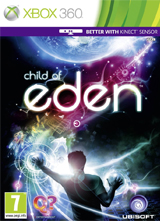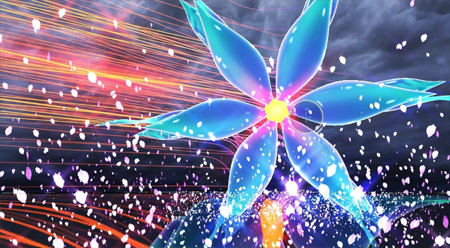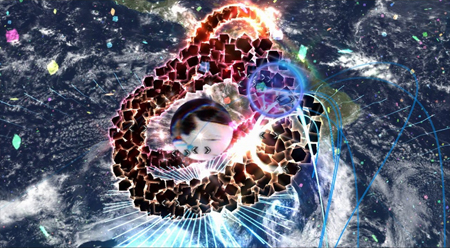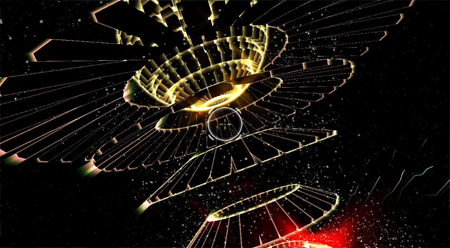Child of Eden – Xbox 360 review
Review by John Cranston

In the 23rd century humanity moves freely amongst the stars, it’s collective memories now stored in a vast network known as Eden. Scientists attempt to introduce Lumi, an artificial intelligence construct, to this database but inadvertently unleash a virus which attacks the memories held within Eden. It’s your job to dive in and purge the infection.
A concept akin to that of a cyberpunk novel, Child of Eden by Q Entertainment is part on-rails first person shooter, part rhythm-action game. With the choice of using either the Kinect sensor or a traditional controller, it’s hugely accessible, defined by its breathtaking visuals and available now for Xbox 360.
Aside from a brief introductory video, the storytelling in Child of Eden abandons traditional structures – there’s no narration, no cut scenes and loading screen plot summation. You must rely on your sense of interpretation as you travel through the different zones in Eden cleansing the memories of the virus that has beset them. If anything, it’s more like a virtual hula dance, with the uplifting music – a mash-up of mellow techno beats and J-pop – complementing the progressive visuals.
Each of Eden’s five levels, dubbed “archives”, are a virtual landscape filled with scenery, objects and enemies that relate to themes like nature, industry and evolution. You are armed with two primary weapons – a rapid firing laser, an eight shot homing missile (the “octolock”) – and a secondary weapon – a room-clearing smart-bomb. If you’re using Kinect, the movement of your hands controls the position of the target reticule, raising your left hand activates the laser, raising your right hand activates the octolock and shoving both arms in the air triggers the smart-bomb.

The enemies are usually more susceptible to one of the two primary weapons, so learning when to use each is the key to survival, as the longer the enemies fly around the screen the more likely they are to send a salvo of damaging purple rockets your way. Using the octolock is as simple as sweeping the reticule over a group of enemies and pushing your hand toward the Kinect sensor to fire, dispatching up to eight enemies in a single shot. Mastery of the octolock requires you to not only shoot eight enemies, but also to fire your shots in time to the beat of the music. Do this correctly and you’re on your way to racking up huge scores.
Although the Kinect sensor is the primary (and my personal preferential) control method, you can use the traditional Xbox 360 pad to play the game with very little difference in the overall experience – the target reticule is assigned to the left analogue stick, the weapons are activated by the face buttons. Given the extra precision the pad can afford, the target reticule becomes smaller when playing with the pad. Any scores you attain with the pad are also grouped separately from the Kinect sensor, so you’re encouraged to master both skill sets.

Travelling through each archive, you’re treated to an audio-visual feast, with psychedelic environments and undulating soundscapes creating a cross-sensory overload. As you immerse yourself in the action, allowing your actions to flow with the bass lines, your weaponry creates sound effects that layer and complement the music. After progressing through each sequence and dispatching the standard enemies, you are then faced with an end of level boss battle which put your reflexes to the ultimate test, their appearance ranging from giant space whales to projectile spewing flowers.
At first glance players may find Child of Eden to be a short game, but as with Mizuguchi’s previous shooter Rez, it’s the repetition and competition that makes it all the more enjoyable. With Xbox Live, your scores are automatically uploaded to global leaderboards and you can instantly compare yourself to both the general public and your own circle of friends. As well as competing on a score basis, each of the archives has a number of completion percentages to compete on – virus purification, support items (health, extra smart-bombs) collected and rewards unlocked for Lumi’s garden.

Obtaining a maximum purification rate is one of the most challenging aspects of this game, though the enemies follow a strict pattern of appearance and behaviour, you only have a very specific window of time in which to kill them. An optional, harder, difficulty mode is available for those who can mastery the standard gameplay, but for those struggling in certain sections, or just wanting to show off the game to people in a non-threatening way, there’s also an easy mode where you take no damage.
Allowing people the opportunity to play the same game, but with a difficulty and control mechanism that they prefer truly makes Child of Eden an accessible title. If you have any reservations about Microsoft’s motion sensor, cast them aside as this is more than just a typical Kinect title and it would truly be a shame to miss out on the enriching emotional experience and aesthetic delights this game has to offer.
 Child of Eden scores a near-seamless 9 out of 10
Child of Eden scores a near-seamless 9 out of 10